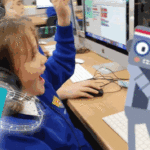This week’s class was all about accessibility in a classroom. Tracy Humphreys came in from BCEdAccess and talked about Technology Inclusion. I never thought about the accessibility of technology, but it makes me realize how inaccessible my blog is. I also didn’t know that there are ways to make it more accessible, and I think that this is a big reason why technology has, and should have such a big role in our curriculum. We live in a technologically advanced world, and if it helps students learn – especially those who have disabilities, then the implementation of technology makes sense.
Tracy came in and first started off her workshop by handing out sticky notes of varying colours – pink, purple and yellow. Each colour represented something different: if you had a pink sticky note, you could stay in the room because she could handle you as a group. Purple meant that she could handle you for a little bit, but after a while, you would have to leave. I had a yellow sticky note, and when she said that whoever had yellow stickies had to leave because she didn’t have any resources or support to handle the yellow sticky note group, I was confused and a little anxious. I didn’t realize at first what was happening, because what guest speaker comes in and tells 1/3 of the class to leave? I’m not going to lie, I did actually believe that I had to leave so started moving to do so, but when she said “I’m just joking,” I was incredibly confused as to what was occurring. This definitely put into perspective what it must feel like to be told to leave because the educator doesn’t have the resources or support available to handle you. Furthermore, it makes me realize that many things are inaccessible, and that we as educators need to put the effort in to create an inclusive community for our students.
Something else that Tracy talked about that really resonated with me was the idea of an “invisible backpack”. Those 25ish students that you may have in your classroom each have their own situations outside of class. They all have different backgrounds, economic status, guardians, etc. I think it’s really important to consider what students are bringing into the classroom that we, as educators, may not be able to physically see. Each student has their own experiences, and it is our job that no matter what their home life is like, they are included and engaged within the classroom. The idea of an “invisible backpack” goes hand in hand with my research on shutting down and coping mechanisms for EDCI 250. The EA in my Link2Practice classroom and I were talking about this “invisible backpack” that students may be bringing in. He said that over the years, he has learnt that he has to be patient with these students as they all are coming from different places. Many times, these students don’t get the respect and care that they need either at home or in school, and this leads to the breakdown of a student, so as educators, we must be that figure in their life who they can trust and establish a relationship with.






